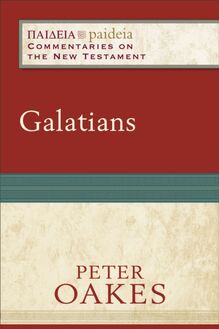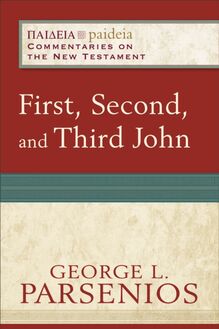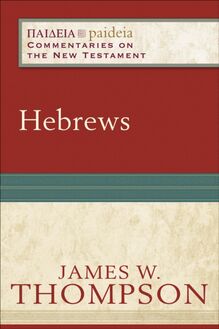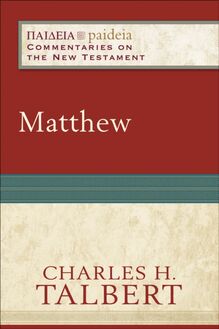-
 Univers
Univers
-
 Ebooks
Ebooks
-
 Livres audio
Livres audio
-
 Presse
Presse
-
 Podcasts
Podcasts
-
 BD
BD
-
 Documents
Documents
-
- Cours
- Révisions
- Ressources pédagogiques
- Sciences de l’éducation
- Manuels scolaires
- Langues
- Travaux de classe
- Annales de BEP
- Etudes supérieures
- Maternelle et primaire
- Fiches de lecture
- Orientation scolaire
- Méthodologie
- Corrigés de devoir
- Annales d’examens et concours
- Annales du bac
- Annales du brevet
- Rapports de stage
La lecture à portée de main
Vous pourrez modifier la taille du texte de cet ouvrage
Découvre YouScribe en t'inscrivant gratuitement
Je m'inscrisMatthew (Paideia: Commentaries on the New Testament) , livre ebook
Découvre YouScribe en t'inscrivant gratuitement
Je m'inscrisEn savoir plus
Vous pourrez modifier la taille du texte de cet ouvrage
En savoir plus

Description
Sujets
Informations
| Publié par | Baker Publishing Group |
| Date de parution | 01 août 2010 |
| Nombre de lectures | 1 |
| EAN13 | 9781441212375 |
| Langue | English |
| Poids de l'ouvrage | 1 Mo |
Informations légales : prix de location à la page 0,0864€. Cette information est donnée uniquement à titre indicatif conformément à la législation en vigueur.
Extrait
G ENERAL E DITORS
Mikeal C. Parsons and Charles H. Talbert
A DVISORY B OARD
Paul J. Achtemeier
Loveday Alexander
C. Clifton Black
Susan R. Garrett
Francis J. Moloney
© 2010 by Charles H. Talbert
Published by Baker Academic
a division of Baker Publishing Group
PO Box 6287, Grand Rapids, MI 49516-6287
www.bakeracademic.com
Ebook edition created 2014
All rights reserved. No part of this publication may be reproduced, stored in a retrieval system, or transmitted in any form or by any means—for example, electronic, photocopy, recording—without the prior written permission of the publisher. The only exception is brief quotations in printed reviews.
ISBN 978-1-4412-1237-5
Library of Congress Cataloging-in-Publication Data is on file at the Library of Congress, Washington, DC.
Except where indicated, Scripture quotations from the Gospel of Matthew are the author’s own translation. Unless otherwise indicated, all other Scripture quotations are from the New Revised Standard Version of the Bible, copyright © 1989, by the Division of Christian Education of the National Council of the Churches of Christ in the United States of America. Used by permission. All rights reserved.
To
colleagues in the department of religion
at Baylor University
friends and fellow learners
Contents
Cover
Series Page
Title Page
Copyright Page
Dedication
List of Figures and Tables
Foreword
Preface
Abbreviations
Introduction
Matthew 1:1–2:23 Birth Narratives
Matthew 3:1–8:1 Part 1: Jesus’s Ministry Begins
Matthew 3:1–4:17 Narrative 1: Jesus Begins to Fulfill All Righteousness
Matthew 4:18–8:1 Discourse 1: Jesus Calls Disciples to Seek God’s Righteousness
Matthew 8:2–11:1 Part 2: Jesus’s Authority Is Revealed
Matthew 8:2–9:34 Narrative 2: Jesus’s Authority Is Manifest in His Mission
Matthew 9:35–11:1 Discourse 2: Jesus’s Authority Enables Disciples’ Mission
Matthew 11:2–13:53 Part 3: Jesus’s Ministry Creates Division
Matthew 11:2–12:50 Narrative 3: Jesus Encounters a Divided Response
Matthew 13:1–53 Discourse 3: Jesus Reflects on the Divided Response
Matthew 13:54–19:2 Part 4: Jesus Focuses on His Disciples
Matthew 13:54–16:20 Narrative 4, Part 1: Jesus’s Disciples Understand More
Matthew 16:21–17:23 Narrative 4, Part 2: Jesus’s Disciples Understand Even More
Matthew 17:24–19:2 Discourse 4: Jesus Tells Disciples How to Relate to Insiders and Outsiders
Matthew 19:3–26:1a Part 5: Jesus and Judgment
Matthew 19:3–20:34 Narrative 5, Part 1: Jesus Teaches about Household Behavior
Matthew 21:1–24:2 Narrative 5, Part 2: Jesus Pronounces about Judgment in the Present
Matthew 24:3–26:1a Discourse 5: Jesus Teaches about Final Judgment
Matthew 26:1b–28:20 Passion and Resurrection Narrative
Bibliography
Subject Index
Index of Modern Authors
Index of Scripture and Ancient Sources
Figures and Tables
Figures
1. Church of the Nativity in Bethlehem
2. Visit of the Magi
3. Flight into Egypt
4. Jordan River
5. Mount of Beatitudes Chapel
6. Synagogue in Capernaum
7. Map of Palestine
8. Sea of Galilee
9. Ancient Fisherman’s Boat
10. Bread-and-Fish Mosaic
11. Mount Tabor
12. Shepherd and His Sheep
13. New Testament Jericho
14. Wailing Wall
15. Map of Jerusalem
16. Traditional Site of the Upper Room
17. Gethsemane
18. Tomb Closed by a Rolling Stone
Tables
1. Parallels between Jesus and Moses
2. Parallels between Jesus’s Baptism and Transfiguration
3. Sermon Parallels between Luke and Matthew
4. Sermon Parallels between Matthew and Luke
5. Nine Beatitudes (Matt. 5:3–12)
6. Two Metaphors (Matt. 5:13–16)
7. Parallels between Matthew 4:23–5:2 and 7:28–8:1
8. Proposed Chiastic Analyses of Matthew
9. Proposed Analyses of Matthew 10 into Sections
10. Proposed Analyses of the Part 4 Narrative
11. The Structure of Matthew 13:54–16:20
12. Old Testament Fulfillment Texts in Matthew 26–28
13. Parallels between Romulus, Augustus, and Jesus
Foreword
Paideia: Commentaries on the New Testament is a series that sets out to comment on the final form of the New Testament text in a way that pays due attention both to the cultural, literary, and theological settings in which the text took form and to the interests of the contemporary readers to whom the commentaries are addressed. This series is aimed squarely at students—including MA students in religious and theological studies programs, seminarians, and upper-divisional undergraduates—who have theological interests in the biblical text. Thus, the didactic aim of the series is to enable students to understand each book of the New Testament as a literary whole rooted in a particular ancient setting and related to its context within the New Testament.
The name “Paideia” reflects (1) the instructional aim of the series—giving contemporary students a basic grounding in academic New Testament studies by guiding their engagement with New Testament texts; (2) the fact that the New Testament texts as literary unities are shaped by the educational categories and ideas (rhetorical, narratological, etc.) of their ancient writers and readers; and (3) the pedagogical aims of the texts themselves—their central aim being not simply to impart information but to form the theological convictions and moral habits of their readers.
Each commentary deals with the text in terms of larger rhetorical units; these are not verse-by-verse commentaries. This series thus stands within the stream of recent commentaries that attend to the final form of the text. Such reader-centered literary approaches are inherently more accessible to liberal arts students without extensive linguistic and historical-critical preparation than older exegetical approaches, but within the reader-centered world the sanest practitioners have paid careful attention to the extratext of the original readers, including not only these readers’ knowledge of the geography, history, and other context elements reflected in the text but also their ability to respond correctly to the literary and rhetorical conventions used in the text. Paideia commentaries pay deliberate attention to this extratextual repertoire in order to highlight the ways in which the text is designed to persuade and move its readers. Each rhetorical unit is explored from three angles: (1) introductory matters; (2) tracing the train of thought or narrative or rhetorical flow of the argument; and (3) theological issues raised by the text that are of interest to the contemporary Christian. Thus, the primary focus remains on the text and not its historical context or its interpretation in the secondary literature.
Our authors represent a variety of confessional points of view: Protestant, Roman Catholic, and Greek Orthodox. What they share, beyond being New Testament scholars of national and international repute, is a commitment to reading the biblical text as theological documents within their ancient contexts. Working within the broad parameters described here, each author brings his or her own considerable exegetical talents and deep theological commitments to the task of laying bare the interpretation of scripture for the faith and practice of God’s people everywhere.
Mikeal C. Parsons Charles H. Talbert
Preface
What! Another commentary on Matthew? After decades of relative neglect, the First Gospel has in recent times been the object of intense scrutiny. Numerous very good commentaries have appeared: Davies and Allison (1988–97), Luz (1989–2005), Hagner (1993–95), Gundry (1982), Harrington (1991), Boring (1995), Carter (2000), Nolland (2005), Schnackenburg (2002), Gnilka (1986–88), Bonnard (1963), and Turner (2008), to mention only a few. When I reluctantly accepted the invitation from Baker Academic to do the volume on Matthew in the new Paideia series and began to read the recent commentaries and other secondary source materials, I wondered, Why does another need to be done? The level of accomplishment in these recent commentaries is very high. When I started through the Greek text of the First Gospel and tried to make systematic sense of Matthew’s narrative world, however, I found myself arriving at what seemed to be a “fresh” approach in nearly every section of the Gospel. It was then that I finally felt another commentary might be in order. What is offered here is an attempt at a fresh reading of the First Gospel, done hopefully with lucid brevity, that is accessible to upper-level undergraduates, seminarians, graduate students, pastors, and teachers.
The secondary literature on Matthew is enormous. A person could spend a career trying to master it. I am very grateful both to Baylor graduate students who in two seminars on Matthew did in-depth histories of research on key segments of the Gospel and to a couple of advanced undergraduate classes at Baylor that did similar surveys of periodical literature for me. Special thanks must go to several graduate assistants who did summer research assignments on ancient parables, miracle stories, conflict stories, and yes, the collection of even more periodical bibliography. Jim McConnell, Alicia Myers, Kalvin Budiman, and especially Jesse Robertson and Julien Smith, thank you for your indispensable efforts on behalf of this project. Thanks must also go to David Oakley, my graduate assistant for 2008–9, who did the work for the abbreviations, and to Tim Brookins, my current graduate ass istant, who prepared the subject index. I also owe a lasting debt to my former colleague, Dr. Sharyn Dowd, who allowed me to teach her doctoral seminar on the Synoptic Gospels twice while she accepted responsibility for my Pauline seminar. It was but another of her gracious efforts on my behalf. It is not possible to express the depth of my appreciation to Dr. Stephen von Wyrick of the University of Mary Hardin-Baylor for his generous act of making available images for this volume from his
-
 Univers
Univers
-
 Ebooks
Ebooks
-
 Livres audio
Livres audio
-
 Presse
Presse
-
 Podcasts
Podcasts
-
 BD
BD
-
 Documents
Documents
-
Jeunesse
-
Littérature
-
Ressources professionnelles
-
Santé et bien-être
-
Savoirs
-
Education
-
Loisirs et hobbies
-
Art, musique et cinéma
-
Actualité et débat de société
-
Jeunesse
-
Littérature
-
Ressources professionnelles
-
Santé et bien-être
-
Savoirs
-
Education
-
Loisirs et hobbies
-
Art, musique et cinéma
-
Actualité et débat de société
-
Actualités
-
Lifestyle
-
Presse jeunesse
-
Presse professionnelle
-
Pratique
-
Presse sportive
-
Presse internationale
-
Culture & Médias
-
Action et Aventures
-
Science-fiction et Fantasy
-
Société
-
Jeunesse
-
Littérature
-
Ressources professionnelles
-
Santé et bien-être
-
Savoirs
-
Education
-
Loisirs et hobbies
-
Art, musique et cinéma
-
Actualité et débat de société
- Cours
- Révisions
- Ressources pédagogiques
- Sciences de l’éducation
- Manuels scolaires
- Langues
- Travaux de classe
- Annales de BEP
- Etudes supérieures
- Maternelle et primaire
- Fiches de lecture
- Orientation scolaire
- Méthodologie
- Corrigés de devoir
- Annales d’examens et concours
- Annales du bac
- Annales du brevet
- Rapports de stage




















